#advent and christmastide
Explore tagged Tumblr posts
Text
The books I received for Christmas!

One school story, one travel diary, one mystery, one historical fiction, one Victorian sensation novel, one fantasy.
26 notes
·
View notes
Text
(Written yesterday) Well, it’s Epiphany, and the end of Christmas proper. I know many continue to celebrate Christmastide all the way until Candlemas, but our tree came down today and I don’t really do much to observe the extended season. So it seems to me that if I’m going to finally revisit Elystan’s point of view in the Christmas chapters, now that I know a little more of his history, I’d best do it before Epiphany is out. Here we go!
[Turns on “Denn es is tuns ein Kind geboren” from “Der Messias.” Since this is Elystan’s pov I really ought to listen in English (tangent: aren’t we Anglophones blessed Handel was in Ireland when he wrote it?) but I thought I’d listen in German as a nod to the Liennese in the room.]
I love the fact that although Elystan’s good with classics when it comes to languages, German is not his forte. This isn’t something you see so often in fiction – that an aptitude for a language, or even languages, doesn’t necessarily apply across the board. (And of course it has the story layer that he and Josiah don’t understand each other, even though they technically speak each others’ languages. Boys, there is so much you’re hiding from others – and so much you don’t see in yourselves.)
Ha. Even here in Corege, Tamett’s Noriberreanness (sp?) is still a point against him in the eyes of the masters.
“[H]e needs to invest in a copy of Bellwell’s Guide for the Traveller in Corege. All good bookstores have it. Changed my life.” Heaven help me, Elystan thinks his jokes are so funny – and I’m smirking despite myself.
“And that distracted Josiah’s attention from the depths of the literary gem he was composing…” Oh that you knew the systematic and painful stuffing down of grief you’re witnessing from outside, Elystan. [I should really be listening to Satie’s Gnossiennes or something equally sombre for Josiah’s composition, but we are not in his head.]
“I’ll leave a box of chocolates in the empty chair in the King’s box, in your memory.” OOF – the joke’s aimed at disgusting Josiah, but yeah, let’s make a joke about an empty chair in the King’s Box right now, Elystan. That’s certainly a good joke for you to make. (I doubt he’s actually thinking along the lines I am, but still.)
Oh, Elystan, your mother would love to take you to the movies if you would let her… And she writes to him faithfully even though she never gets any back. I understand why there’s such an enormous rift between them, and she’s certainly not blameless – but this must be a hard time for her, having realized at least some of the damage she’s caused, how broad the gulf is, spent the summer trying to mend their relationship among many other things, then had to send him away for his own sake. And she never hears from him. That would be hard. These stories have such huge themes of attachment and how hurt to that attachment ripples into so many seemingly unrelated areas of life. My heart goes out to both Elystan and Bethira.
Oh gosh, he almost asked Josiah was he was going to do with his Mother for Christmas. The anniversary of his mother’s December death is almost here, and right this moment he’s writing a paper about how above grief a real man needs to be. Josiah heard that pause loud and clear.
The way schoolboy culture won’t let them just say “family.” (It’s the heart of all this, it’s all about family, and they can’t say it, they can’t say it. They’re not even consciously thinking about it – they’re all just copying each other – but they haven’t got families anymore. They’ve got [airy wave of the hand] people.”
Josiah wrinkled his nose. “How about the rest of the year?” If he had not been such an overgrown lump, Elystan would have knocked him out of his seat. – Oh boy. Knowing what Elystan’s rest of the year has been like this past year, that one smarts even more.
I am eternally amused by Elystan’s ongoing crocodilianess.
He misspelled “grievous.” No undertones there.
Love these boys so much. Since this is a revisit in light of what I know of their previous lives, these comments are likely to all tend to the “oh no” direction, but also I am smiling so lovingly at all of them.
A Christmas Chapter: Elystan’s POV
Last year I wrote two versions of this story, from Tamett’s and Josiah’s POVs. I had intended to leave it there, but a friend wanted Elystan’s POV, so after a long struggle of trying to find a story I’d never really planned between the lines of the existing pieces, here is the third and final version.
This one runs very long, nearly 17000 words. It’s not perfect, probably has wording issues right and left, and it feels a bit more like a series of random events than a cohesive whole, but I’m sick of fussing with it for now, and you’re very welcome to tell me (politely) what could be improved.
In case you’re unfamiliar with these characters, Elystan is the thirteen-year-old son of a disgraced former king of Corege (one of several nations in this Edwardianesque world). After circumstances that have resulted in his having a massive grudge against his mother and his half-brother Delclis (the current King), he has been sent to Hollingham, an elite boarding school, where he rooms with Josiah, Crown Prince of Lienne, and has befriended Josiah’s paid companion Tamett. They’re about to reach the end of their first term, and Elystan is faced with the daunting prospect of having to spend the Christmas holidays with his dearly beloathed family.
Keep reading
#Alas - I got caught up in obligations before I could get too far in the chapter and Epiphany's over. But maybe I'll be a bit unseasonable#or turn into a real Candlemas celebrator for the sake of finishing this another time.#the blackberry bushes#advent and christmastide
29 notes
·
View notes
Text

December offers.
#odinson tea&tarots table#free readings#reiki and yoga with odinson#free tarot readings#december#yuletide#advent#epiphany#12 days of christmas#christmastide#new year's eve#winter holidays#reikimaster#past lives sessions#tarots#discord#reincarnation
1 note
·
View note
Text
Christmas in Fallen London, 2024
Fallen London rings in another year (yes, that year is 1899, again). Christmastide – and the customary covering of 'snow' – is set to fall upon the city once more.
What's New?
Christmas comes with a host of seasonal treats and novelties. Here's what we've cooked up this year, most of which will arrive on the 2nd of December from 'Explore the Festive Season,' available throughout London.
Mr Treats Ratwork Emporium

The Fifth City's foremost purveyor of seasonal delights opens up its exclusive establishment during the Christmas season, offering intricate wonders and custom-made marvels. A new commission is available this year, alongside last year’s.
Mr Treats Ratwork Emporium will open on the 13th December and close on the 25th, and is available anywhere in London. Commissioning an item from Mr Treats will begin a short story that will progress throughout the Christmas season, ending on Christmas Day.
The Undercrofts Ancillary
Penstock himself – owner of the Neath's foremost land agency – is out in force this festive season, offering that most rare of gifts: treasures from the Bazaar's very own vaults. From the 2nd of December, purchase a Frosted Debenture and claim a brand new piece of equipment, or, if you're feeling especially magnanimous, send the Debenture to a friend for them to use.
Purchase a Debenture for 30 Fate in 'Explore the Festive Season'. Once purchased, they can be freely gifted to a friend on your contact list. There are two new items available this year, with more to come in future years.
New Options for Profile Page Customisation
We've added some seasonal new options for profile page customisation! A new cameo frame – 'Yuletide Cheer' – will be available for purchase in 'Explore the Festive Season', for those who wish to decorate their profile in the trappings of the season. We've also added a few new headers – some of which have never been seen before! You'll see them, soon enough…
A Seasonal Miscellany
In addition to new treats, Fallen London will be full to the brim with the hustle and bustle of Christmas, all the way into the New Year.
The Fallen London Advent Calendar
From the 1st until the 25th of December we’ll be handing out advent treats via the Fallen London Advent Calendar! Each will give you a snippet of Yuley narrative, and something besides: trinkets, magpie-treasures, and occasionally something rare.
Look for the storylet 'Advent: A Calendar of Encounters', available anywhere in London. You’ll be able to ‘catch up’ and claim any and all rewards until the end of the year – however, opening the doors on the days when they become available will give you a little extra.
As ever, rewards for Advent shift year to year, though there are some fixed points. Old doors are retired, new doors are added. Remember always that some doors cannot be unopened.
Christmas Cards
Tell your friends you are thinking of them this festive season. (Don’t tell them what you are thinking of them.) Neathy Christmas cards return: four designs, with room for your own message!
Your stock of cards will be replenished weekly by Time, the Healer, starting from noon on the 2nd of December. You can send cards, and engage in other festive jollity, in the storylet 'Explore the Festive Season', anywhere in London.
You need to be acquaintances with another player before you can send them a Christmas card. To become acquainted with somebody, 'Attend to Matters of Society' in your Lodgings, where you can send a calling card to a contact.
Find friends to exchange cards with on our forums, the Fallen London subreddit, or the Official Failbetter Discord.
Snowfall!
Every week during the Christmas season, when Time the Healer visits, clear your doorstep of Neath-snow (or fob the task off on others). They say the stuff is called 'lacre'. They say you shouldn't throw it away. What is it? Where does it fall from? And why do the Masters prize it so highly?
The Twelve Days of Mr Sacks
After Christmas, field off visits from the Crimson Beast of Winter. Every day from the 25th December to the 5th January, encounter Mr Sacks and satiate him with gifts. What lies beneath its robe? Investigate on your own behalf, or join forces with a range of possible allies. HO. HO. HO.
Visit Penstock's Wicket
Penstock's shop is right on the flank of the Bazaar, and is much larger than it looks. From the 5th of January, descend into the depths around the Bazaar and spend your knowledge of the season's mysteries to claim special rewards. This is a chance to acquire various rewards, including unusual lodgings and perhaps, briefly, even your own noman.
The festive season in Fallen London will wrap up in the last week of January. You’ll notice that there is no premium story listed here: we were going to release one in January, but all things considered, we’ve instead opted to focus our efforts elsewhere.
We hope you have a happy – or at least interesting – festive season in the Fifth City.
And one more piece of business
From the 27th of January, Fate will cost slightly more. This is an inflationary adjustment, as it’s been almost two years since the last change to Fate prices (though we're still behind the rate of inflation since the game started in 2009).
10 Fate will be $3.50, and 100 Fate $28. The best value price for a single point of Fate will be $0.25; a small increase over about $0.23 today.
Prices in other currencies will reflect these increases, as determined by the current exchange rates, which we update regularly. The price of subscriptions won’t change.
126 notes
·
View notes
Text
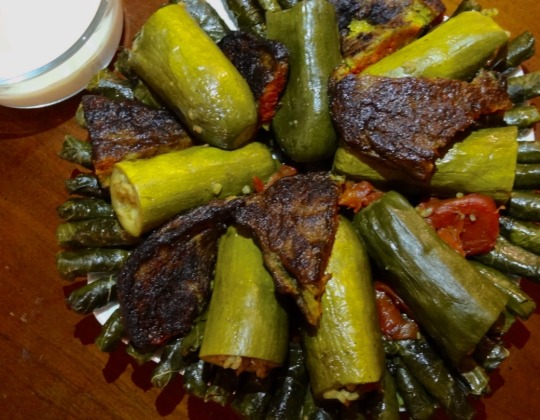

[ID: First image is a plate of stuffed grape leaves, zucchini, tomatoes, and lamb chops next to a bowl of yoghurt, seen from the top; second image is a close-up on the grape leaves and stuffed zucchini, seen from the side. End ID]
كوسا محشي مع ورق العنب / Kusa muhashshi m'a waraq al-'anub (Stuffed zucchini with grape leaves)
"كُوسَا" ("kūsā"), meaning "zucchini" or "courgette," is from the Persian "کوسه" ("kūse"), meaning "shark" or "beardless man"; it is so called because of its smooth skin. "مُحَشّي" ("muḥashshi" or "maḥshshi") means "stuffed"; مَعَ ("ma'a") is "with"; "وَرَق" means "leaf" (or "paper"); and "عِنَب" (Levantine pronunciation: "'ineb") is "grape." (Grape leaves are also sometimes called "وَرَق الدوالي," "waraq ad-dūwāli," in Palestine). Thus: stuffed zucchini with grape leaves! Stuffed grape leaves themselves date back to Medieval times, and are popular amongst various regions throughout what was previously the Ottoman Empire; however, each cuisine has slight variations in how they are cooked, and what they are called.
To prepare Palestinian duwali, one stuffs grape leaves with one of two types of filling: a meat one, using rice, ground lamb, and a variety of aromatic spices; or a vegetarian one, including rice, herbs, tomatoes, and peppers. A large pot is then prepared, sometimes lined at the bottom with meat—usually rack of lamb, but sometimes chicken, or whatever else is to hand. The meat is topped with sliced tomatoes; sometimes, with hollowed baby zucchini or eggplant ("بَاذِنْجَان"; Levantine pronunciation: "bātinjān") stuffed with the same filling; and, finally, with the grape leaves. The whole is simmered in an aromatic broth before the finished dish is tipped out of the pot into a large platter. It is usually served with plain yoghurt, which plays beautifully against the mild sweetness of the zucchini, the slightly sour grape leaves, and the savory, tender spiced rice filling.
This dish is usually made in large batches, with the women of the family sitting in a group around the kitchen table rolling tiny grape leaves. It was traditionally made in the spring or summer, when zucchini and grape leaves were in season—but it is now often made as one of the centerpieces of a Christmas meal, with frozen grape leaves that are thawed in hot water.
Christmas (Arabic: عِيد الْمِيلَاد, "ʕīd al-mīlād," "feast of the Nativity," or "mīlād," "Nativity" for short) is a Christian festival and feast day commemorating the birth of Jesus Christ. The largest meal of the Christmas season is usually eaten on Christmas Eve, which is celebrated on the 24th of December (in the Gregorian Calendar) by Palestinian Catholics. Large families travel across Palestine to come together for a dinner featuring bread, several vegetable salads, meat dishes (such as stuffed lamb or chicken), grape leaves, topped flatbreads and other savory pastries, and an assortment of cookies. Chocolates are often given to children.
Christmas festivities are observed in Palestine during Advent ("مَجِيء المَسِيح," "madji' al-masīḥ": "the coming of Christ") and Christmastide, and at different times by different sects of Christians. One of the most common destinations for Christian tourists is the ancient city of Bethlehem (بَ��ْت لَحْم, "bayt laḥm," lit. "house of meat"; related to the Aramaic בֵּית לַחְמָא "house of bread"); pilgrims flock from around the world, and from other locations in Palestine, to attend church services and festivities and to visit holy sites. The Church of the Nativity (كَنِيسَة المَهْد, "kanīsa al-mahd"), so called because it is built on the place where Jesus was believed to have been born, is a particularly popular destination.
Bethlehem also has an ancient history as a home to many of Palestine's grape orchards; after the widespread destruction caused by the Crusades, some of the only vineyards in the area were in Bethlehem. Christians in Bethlehem have tended these grapes since Medieval times; today, farmers and companies in Bethlehem (such as Cremisan) make wine from several ancient varieties.
Despite hosting one of Christianity's most important sacred sites, Bethlehem's population of Christians has been continually shrinking for the past century. Arab Christians comprised an estimated 84% of the population in 1922, but by the end of the British Mandate years (1948) this number had dropped to 75%. By 1998, Christians made up a minority, at 33% of the population, and by 2007 this had dropped again to 28%. This dramatic decrease is a microcosm of the situation in Palestine overall, where the Christian population dropped from an estimated 20% in 1948, to just 2% in 2007, to less than 1% in 2017. Statistics from the Gaza Strip look similar. Bethlehem, however, remained a significant part of Palestine's Christian enclave: nearly half (49.4%) of all the Christians in Palestine in 2017 lived there.
As of 2004, an estimated 56% of all people with Palestinian Christian ancestry were living outside of Palestine. The trend shows no signs of slowing down: a 2020 survey found that a much higher proportion of Christians than Muslims wished to leave Palestine. Respondents cited dire economic circumstances, the dangers of military and settler violence, and religious intolerance, including job discrimination and difficulty having church marriages legally recognized.
Bethlehem is nearly completely surrounded by Israeli settlements, which hem residents in and threaten to cut off connection to other Palestinian territories. Israel has used its military codes, as well as its control of private companies, to annex nearly 2,000 acres of land in Bethlehem's immediate surroundings since 2004. Residents of Bethlehem's villages are subject to violent assaults by West Bank settlers, as well as destruction of property (such as uprootings of crops).
The economy within Bethlehem is also threatened by Israeli occupation. Income that could previously be made through tourism has dropped significantly due to settler violence, and to Israeli control of all borders and crossings into and out of occupied Palestine. In 2013, Israeli travel companies used this latter advantage to provide various services to 1.16 million pilgrims to Bethlehem's Church of the Nativity alone, starving Palestinian companies and tour guides out and leaving many in Bethlehem unemployed. Tourism to various holy sites injects billions of U.S. dollars per year into Israel's economy. Israeli winemakers, who had previously sourced grapes from Palestinian farmers in Bethlehem, have also started cutting Palestinians out, turning to growing grapes themselves on expropriated land.
The Palestinian Authority has stated an intent to try to keep Christians in the West Bank by promoting Christmas festivities. In 2022, a Nativity scene and Christmas tree were publicly displayed in مَيْدَان المَهْد ("maydān al-mahd"; Manger Square) in Bethlehem: the Catholic Church in Bethlehem lights the tree for Advent, beginning four Sundays before Christmas. A Christmas parade, with brightly lit floats carrying Christmas trees, people dressed as angels and Santa Clauses, and Nativity scenes with live actors, took place again for the first time after having been interrupted due to the Coronavirus pandemic, and was broadly attended by Muslims and Christians.
Another parade marched through streets near the Church of the Nativity for Christmas Eve in 2021: musicians beat drums, played bagpipes, and waved Palestinian flags while onlookers ululated and cheered. Bethlehem's Catholics attend a قُدّاس مُنْتَصَف اللَيْل (quddās muntaṣaf al-layl; Midnight Mass) service in St. Catherine's Church, with prayer, carol-singing, and the burning of incense; another service is held in the Church of the Nativity on January 6, where Christmas falls on the Orthodox calendar.
During the first and second اِنْتِفَاضَات ("intifāḍāt"; singular اِنْتِفَاضَة "intifāḍa," "uprising" or "rebellion"), the tree in Bethlehem was no longer lit due to widespread mourning—Masses continued, but not the public festivities. Instead, private celebrations would take place within the home. Some families began buying artificial Christmas trees rather than real ones, since they were easier to tuck away from windows where they would not be seen from the outside. Even after the lights returned, Israeli military border walls, checkpoints, and curfews hampered Christmas celebrations for many: Christians from Gaza need permits from the Israeli military to take pilgrimages to, or visit family in, Bethlehem and other places in the West Bank, and the majority of those requested are not granted. كنيسة المِيلَاد الإِنْجِيلِيّة اللوثرية ("kanīsa al-mīlād al-ʔinjīliyya al-lūthri"; Evangelical Lutheran Christmas Church) referenced the ongoing genocide in their Nativity scene, in which a baby Jesus wrapped in a Palestinian كُوفِيَّة (kūfiyya) lies amidst a pile of rubble.
Mayor Hana Haniyeh expressed that the local economy's "crash" was "nothing" compared to "what's happening to our people and Gaza." In 2021, the Catholic community in the Gaza Strip comprised 133 people, or 0.0056% of the population (out of 1,017 Christians of all denominations; 0.043% of the population). The sole Catholic parish in Gaza, overseen by the كَنِيسَة العَائِلَة المُقَدَّسَة ("kanīsa al-'āʔila al-muqaddasa," Holy Family Church), faced the destruction and partial destruction of several buildings by Israeli airstrike in 2014, and again in 2021.
During the 2023 genocide, parish buildings including the church, monastery, school, orphanage, and مَرْكَز تُومَا الأكُوينِي ("markaz tūmā al-ʔkoni"; Thomas Aquinas Center) have sheltered hundreds of Christians and Muslims. On the 16th of December, 2023, and amidst heavy bombing of the surrounding area, Israeli soldiers, claiming that the parish hid a missile launcher, opened fire on anyone leaving the church, killing two women.
Help Palestinian Christians evacuate Gaza
Support traditional woodworking and glass-blowing in Bethlehem
Try Cremisan Palestinian wine
Equipment
Large, thick-bottomed stockpot or Dutch oven
Vegetable corer (مأورة "maʔwara"), or thin teaspoon measure
Ingredients
For the dish:
About 300g grape leaves
2kg baby zucchini (كوسا صغير)
2 large beefsteak tomatoes
Zucchini should be about 1" in diameter and 5" in length. If you don't have access to baby zucchini, use the smallest you can find. I halved my zucchini lengthwise to get the correct size.
If you happen to have a grape vine, harvest grape leaves early in the spring for this recipe, and freeze them for use throughout the year. Otherwise, you should be able to find jarred grapeleaves in a halal grocery store. You will want the smallest, earliest-harvested (say, March-May) grape leaves that you can find.
For the filling:
600g (3 cups) Egyptian white medium-grain rice
300g (about 1 1/2 cups) ground beef substitute (to replace minced lamb)
1/4 cup good olive oil
5 tsp allspice, or Palestinian 7-spice / mixed spice (بهار مشكل)
1 Tbsp turmeric (optional)
1 1/2 tsp black pepper
1 tsp cinnamon (optional)
Large pinch ground cardamom, from 2-3 green cardamom pods (optional)
Salt, 1/4 tsp, or to taste
Spices used in this dish may be as minimal as salt and black pepper. Allspice or 7-spice are almost always included. Cinnamon and turmeric are the next most common additions; occasionally, cardamom is added. I have gone for a maximalist, aromatic approach here, because the taste of other ingredients (e.g. zucchini) is quite mild.
You will want a medium-grain white rice for this dish—the rice should become extremely tender without being fluffy or sticky. Egyptian medium-grain rice can be found at a halal grocery store from a brand such as Baraka. If you can't locate any, another kind of medium-grain white rice will do.
To cook:
Vegan lamb chops, or other meat substitute of your choosing
Juice of 1 lemon, or 1/4 tsp citric acid (if using jarred grape leaves that don't include citric acid)
1 Tbsp tomato paste
1/4 cup good olive oil
Salt, black pepper, and 7-spice
Vegetarian chicken bouillon cube or stock concentrate
Water to cover
Chicken stock from making another dish is sometimes used in place of water here; or else a chicken boullion or Maggi cube may be added. You could also use a vegetarian beef stock concentrate, or a bit of soy sauce, to mimic the stock that would result from lamb being simmered at the bottom of the pot.
Instructions:
Prep work:
1. Prepare the rice. Place a strainer in a closely-fitting bowl and add the rice into the strainer. Fill the bowl with cool water and rub the rice between your hands to remove excess starch. Lift the strainer out of the water to strain the rice, and pour the starchy water out. Repeat this process 3-4 more times, until the water comes away mostly clear.
(Starchy water from the first 2 or 3 washings can be saved and used to thicken soups and stews. If you're not sure of the cleanliness of your rice—i.e. if it came in a container that was not airtight—only use water from the second washing onwards.)
2. Return rice to bowl and pour cool water to cover. Soak for an hour.
3. Prepare the zucchini. Cut the tips off of both sides of the zucchini, only taking off as much as you need to. (If your zucchini are over 6" / 15 cm or so long, cut them in half widthwise).
4. Starting from the tip (or, if it's the 'bottom' half of the zucchini, the cut end), hollow out each squash with a vegetable corer until a ring of flesh about 1/8" (1/3 cm) wide remains around the edges. If you don't have a vegetable corer, use a small teaspoon: make a small divot in the center of the zucchini and then deepen it, constantly rotating the zucchini as you push the spoon in, to hollow the zucchini.

(Save the zucchini flesh to use in a soup or stew later!)
5. Soak the zucchini. Place zucchini in a large bowl of salted water and let soak while you prepare the grape leaves.
6. Prepare the grape leaves. If using grape leaves from a jar, pull out a group (they will probably be rolled together) and lay them flat on a plate. Go through grape leaves to find leaves of appropriate size; anything too much larger than 4" in diameter should have its outer leaves shortened with a sharp knife; anything larger than 5 or so inches should be halved down the central vein, and then flled "sideways." Lay the grape leaves out in the bottom of a large bowl or tray.
7. Soak the grape leaves. Pour just-boiled water over the grape leaves and let sit 10-15 minutes.
8. Meanwhile, remove zucchini from soaking water and place on a wire rack, hollow-side-down, to drain while you make the filling.
To make the filling:
1. Drain the rice and shake the strainer to remove excess water. Combine all spice ingredients together by kneading well with your hands. I recommend toasting the spice for a minute or two in a small, dry skillet on medium-low hest, until fragrant.
To stuff the vegetables:
1. Stuff the zucchini. Once the zucchini are drained, use your figners to push filling down into the hollowed openins. Don't fill them up all the way, or the rice will come out as it expands; leave about 3/4" (2 cm) between the top of the filling and the edge of the zucchini (about the length of a finger up to the distal knuckle).

2. Remove grape leaves onto a wire rack to drain for 4-5 minutes. They will be easiest to roll if they are still slightly damp.
3. Stuff the grape leaves. Add a very small amount of filling (a bit more than 1/4 tsp and less than 1/2 tsp) in a horizontal line towards the bottom edge of a grape leaf.
The leaves will be rolled much like burritos: fold the bottom edge up once or twice to cover the filling, fold the sides in over that, and then roll away from you, folding the tip of the leaf inward as well if needed to avoid having any spikes sticking ourt.
Roll tightly enough that the leaves will not come undone with jostling, but loosely enough to give the rice some room to expand. I did this by leaving a tiny bit of space on each side of the filling as I folded the edes in. Leaves can be stuffed by laying them flat on the counter, or by holding them in your non-dominant hand.

Keep going until you run out of grape leaves. Keep any extra filling to stuff tomatoes, eggplant, etc.
At some point during this process, taste a bit of a grape leaf and determine if it is sour enough that you will not need lemon juice later in cooking.
To cook:
1. Coat the bottom of a large stockpot with a couple tablespoons olive oil. Slice a large tomato and arrange the slices on the bottom of the pot so that they do not overlap.
2. Add stuffed zucchini, either standing up (filling-side-up) or arranged horizontally in a single layer, depending on the size of your pot.

3. Top with stuffed grape leaves; just pour them in and give the pot a good shake, or arrange them in concentric circles.

4. Mix just-boiled water with spices, stock bouillon or concentrate, tomato paste, olive oil, and lemon juice (if using). Pour water into the pot until it comes up to the bottom of the stuffed grape leaves.
5. Choose a heavy plate that fits inside your pot with an inch or so to spare (to allow steam to escape) and weigh the grape leaves down.
6. Raise heat to return water to a boil. Lower heat to medium-low and keep at a low simmer for an hour, until zucchini is very tender, rice is fully cooked and a bit mushy, and there is almost no water in the pot. Remove from heat and allow to cool slightly.
To serve:
1. Cover the top of the pot with a large, upside-down platter and turn over the whole to empty the contents of the pot into the platter. Lift the pot straight up.
2. Shake the platter slightly to encourage the stuffed vegetables to spread out. Remove any grape leaves that have burst or come unfolded, if you want to. Some blackening of the pieces that had come into direct contact with the bottom of the pot is not a problem.
3. Arrange seared lamb chop pieces among the stuffed vegetables.
Serve warm with lemon slices, yoghurt, pickles, and side salads.
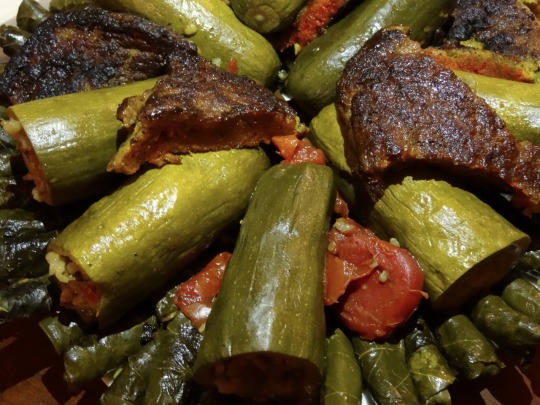
367 notes
·
View notes
Text
If he was castrated, then how did he knock her up? It'd make more sense they were both transgender especially with the bullying.

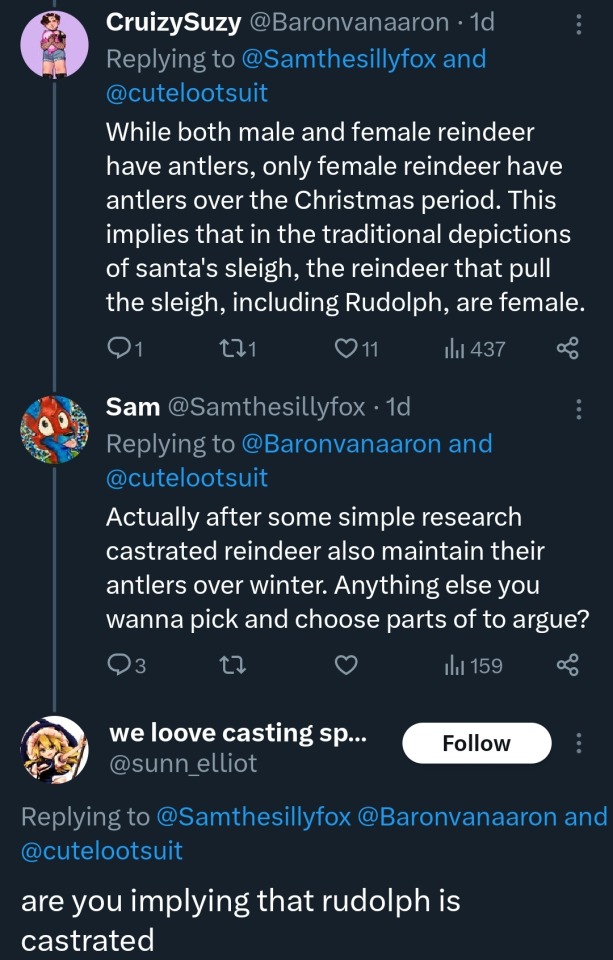

i think twitter is actually really funny and good sometimes. where else are you seeing shit like this
#I'm not watching this crap again you can't make me#I don't care if it's still Christmas#Santa shit is Advent not Christmastide
64K notes
·
View notes
Text

Crown of Light by Sulamith Wulfing (1901-1989)
"Saint Lucy’s Day, also called Lucia Day or the feast of Saint Lucy, is a Christian feast day observed on 13 December, commemorating Lucia of Syracuse, an early-4th-century martyr under the Diocletianic Persecution, who according to legend brought food and aid to Christians hiding in the Roman catacombs, wearing a candlelit wreath on her head to light her way and leave her hands free to carry as much food as possible. Her feast day, which coincided with the shortest day of the yer prior to calendar reforms, is widely celebrated as a festival of light. Falling within the Advent season, Saint Lucy’s Day is viewed as a precursor of Christmastide, pointing to the arrival of the Light of Christ in the calendar on Christmas Day." ~Wikipedia
38 notes
·
View notes
Text
In honor of the first Sunday of Advent... and a reminder that the Christmas season begins on December 24th ;)
23 notes
·
View notes
Text
Christmas Carols

Christmas Stories with various characters. Ratings and Warnings included in individual stories
Frankie Morales:
The Advent Calendars {Frankie Morales x F!Reader}
A Very Dirty Christmas {Frankie x F!Reader x Will x Benny x Pope}
Agent Whiskey:
Christmas in Cabo {Agent Whiskey x F!Reader}
Pero Tovar:
Christmastide {Pero Tovar x F!Reader}
A Family for Christmastide {Pero Tovar x F!Reader}
Javier Peña:
El Milagro de Navidad {Javier Peña x F!Reader}
Marcus Pike:
A Princess for Christmas {Marcus Pike x F!Reader}
Christmas Honeymoon {Marcus Pike x F!Reader}
Dave York:
A Nanny for Christmas {Dave York x Plus Sized!F!Reader}
Christmas Affair {Dave York x F!Reader}
Dieter Bravo:
Christmas For Hire {Dieter Bravo x F!Reader}
Joel Miller:
White Christmas {Joel Miller x F!Reader}
#pedro pascal#the mandalorian#pero tovar#marcus moreno#agent whiskey#dieter bravo#max phillips#ezra prospect#frankie morales#marcus pike#max lord#dave york#oberyn martell#javi gutierrez#tim rockford#zach wellison#joel miller
17 notes
·
View notes
Text
OMG thank you @winterinhimring & @oldshrewsburyian ! I've been saying this on the socials for YEARS! Christmas STARTS on the 25th, not ends!!! It's where the 12 Days of Christmas come from. I will not be denied my Christmastide just because we've hosed up the calendar.

20K notes
·
View notes
Text
Goodness of Christmas Day:
I had thought of getting up really early and going to the candlelight dawn Mass, but the previous night I stayed up late working on report cards, and I really needed the sleep. So it is good I was at Christmas Eve Mass! I rested. Lots of waking through the night, but every time I checked the time, I got to enjoy delightful thoughts like, "Ah. Scrooge is with such-and-such ghost right now."
Nice slow morning. I spent some of it listening to choral Christmas music and sending good wishes to all the good people. Also did some work on "Christmas in Morceaux." I hope to have something to post before the octave's out.
As a household of adults who go to the vigil, sleeping in is preferred on Christmas morning! Around noon, we did stockings and I was given some books. We sang, we prayed. Some people worked on a puzzle. It was lovely.
Kaladin was feeling good today. ;-) (This is ominious. Oho, starting the book with him being all happy with his family are you, Brandon? This does not bode well for what's coming.)
Lots of chopping potatoes and stirring gravy and all the rest.
Reading Helene Hanff's The Duchess of Bloomsbury Street in between making things for dinner.
The dinner was Cratchit-worthy! A family effort, but most especially praise to my mother. And fine pumpkin pie.
Nice nap.
We do family read alouds all year round. We're working through a short story anthology right now. Just finished a late Victorian story about a murderer. I like playing Tetris while we read.
in that vein - the family called for a movie, and Brother One especially wanted that RSC version of Much Ado that's set at Christmas, but I just couldn't do a full-length one. So they were very accommodating, and went with my suggestion of "The Blue Carbuncle" with good old Jeremy Brett as Sherlock Holmes.

Wonderful we Catholics don't consider one day long enough to celebrate the day itself, and we've got a whole octave where it's technically Christmas Day for over a week before we hit regular old Christmastide.
15 notes
·
View notes
Text
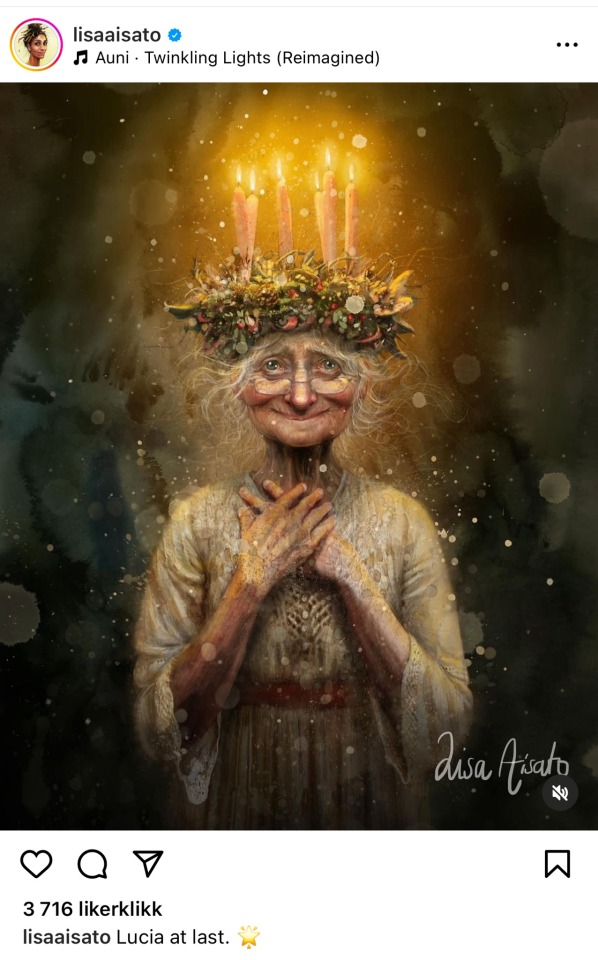
Happy Lucia 🌟
Saint Lucy's Day, also called the Feast of Saint Lucy, is a Christian feast day observed on 13 December. The observance commemorates Lucia of Syracuse, an early-fourth-century virgin martyr under the Diocletianic Persecution.[1] According to legend, she brought food and aid to Christians hiding in the Roman catacombs, wearing a candle lit wreath on her head to light her way, leaving both hands free to carry as much food as possible.[2][3] Because her name means "light" and her feast day had at one time coincided with the shortest day of the year prior to calendar reforms, it is now widely celebrated as a festival of light.[4][5] Falling within the Advent season, Saint Lucy's Day is viewed as a precursor of Christmastide, pointing to the arrival of the Light of Christ in the calendar on December 25th, Christmas Day.[1][6]
Saint Lucy's Day is celebrated most widely in Scandinavia, Italy and the island nation of Saint Lucia, each emphasising a different aspect of her story.[2] In Scandinavia, where Lucy is called Santa/Sankta Lucia, she is represented as a woman in a white dress symbolizing a baptismal robe and a red sash symbolizing the blood of her martyrdom, with a crown or wreath of candles on her head.[7]
In Norway, Denmark, Sweden and Swedish-speaking regions of Finland, as songs are sung, girls dressed as Saint Lucy carry cookies and saffron buns in procession, which symbolizes bringing the Light of Christ into the world's darkness.[7][8] In both Catholic and Protestant churches, boys participate in the procession as well, playing different roles associated with Christmastide, such as that of Saint Stephen or generic gingerbread men, Santa Clauses, or nisses. The celebration of Saint Lucy's Day is said to help one live the winter days with enough light.[7]
A special devotion to Saint Lucy is practised in the Italian regions of Lombardy, Emilia-Romagna, Veneto, Friuli Venezia Giulia, Trentino-Alto Adige, in the north of the country, and Sicily, in the south, as well as in the Croatian coastal region of Dalmatia. In Hungary and Croatia, a popular tradition on Saint Lucy's Day involves planting wheat grains that grow to be several centimetres tall by Christmas Day, representing the Nativity of Jesus.[6
Source: Wikipedia
7 notes
·
View notes
Text


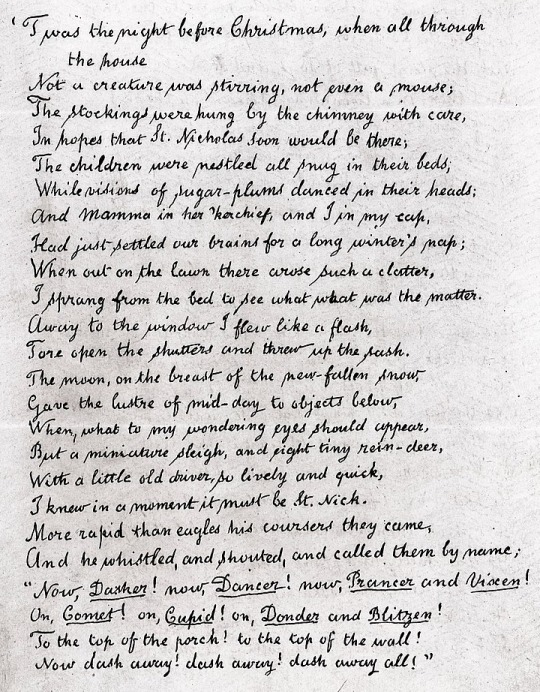
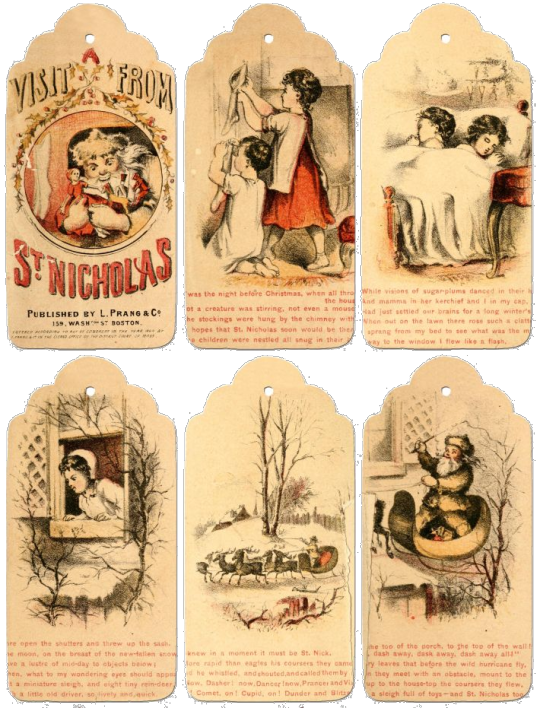
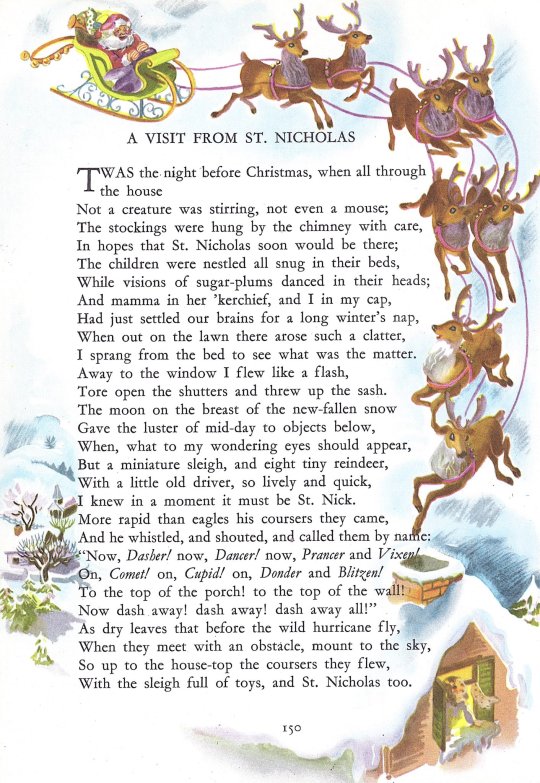



A Visit From St Nicholas 🎅 By Clement Clark Moore
A Visit from St. Nicholas, more commonly known as The Night Before Christmas and 'Twas the Night Before Christmas from its first line, is a poem first published anonymously under the title Account of a Visit from St. Nicholas in 1823 and later attributed to Clement Clarke Moore, who claimed authorship in 1837. The poem has been called "arguably the best-known verses ever written by an American" and is largely responsible for some of the conceptions of Santa Claus from the mid-nineteenth century to today. It has had a massive effect on the history of Christmas gift-giving. Before the poem gained wide popularity, American ideas had varied considerably about Saint Nicholas and other Christmastide visitors. A Visit from St. Nicholas eventually was set to music and has been recorded by many artists.
Plot On the night of Christmas Eve, a family is settling down to sleep when the father is awakened by noises on their lawn. Looking out the window, he sees Santa Claus (Saint Nicholas) in a sleigh pulled by eight reindeer. After landing his sleigh on the roof, Santa gets down the chimney. He carries a sack of toys, and the father watches his visitor deliver presents and fill the stockings hanging by the fireplace, and laughs to himself. They share a conspiratorial moment before Santa bounds up the chimney again. As he flies away, Santa calls out "Happy Christmas to all, and to all a good night."



Legacy and Honors
In 1911, the Church of the Intercession in Manhattan started a service on the Sunday before Christmas that included a reading of the poem followed by a procession to Moore's tomb at Trinity Church Cemetery on the Sunday before Christmas. This continues until this day.
Clement Clarke Moore Park, located at 10th Avenue and 22nd Street in Chelsea, is named after Moore.
A playground opened in the park November 22, 1968, and was named for Moore by local law the following year. In 1995 it was fully renovated, and new trees were added. Local residents gather annually there on the last Sunday of Advent for a reading of "Twas the Night Before Christmas".
PS13 in Elmhurst, Queens is named after Clement C. Moore.
Clement Clarke Moore (July 15, 1779 – July 10, 1863) was an American writer, scholar and real estate developer. He is best known as author of the Christmas poem "A Visit from St. Nicholas."
3 notes
·
View notes
Note
Regarding other non-trinitarian groups, I would not consider Oneness Pentecostals and Arians to be theologically Christian either, though again, as far as anthropology goes, I think it makes sense to place them in the "Christian" category. Same goes for various other non-trinitarian religious groups that emerged from Christianity (Jehovah's Witnesses, La Luz del Mundo, etc.). I might not consider myself to be a sibling in Christ with y'all or these various other groups, but I don't deny we have a common history.
Regarding pre-Nicene Christianity, I feel like the question implies that the Trinity was entirely unheard of before the Council of Nicaea, which is not my understanding of Christian history. Even before Nicaea, we still have the Trinitarian formula and the word Trinity, and while a lot of the explanatory language isn't quite what we're familiar with (e. g. iirc Justin Martyr uses some slightly different wording than what most modern orthodox Christians would be accustomed to), the underlying ideas are very much there. Based on what we do have, I don't think it's too much of a stretch to say that the idea was there even if the Nicene Creed itself wasn't there yet.
I also think it's worth bearing in mind that prior to Nicaea, the Church spent a lot of energy just. trying to survive. While persecution was at times more localized, and some government officials were more tolerant than others, this was still the Church under such delightful characters as Nero. That doesn't mean Church councils didn't happen (The Book of Acts describes the Council of Jerusalem, for example), but most of the pre-Nicene councils were not on the same scale as Nicaea (which makes sense; when you're facing off-and-on persecution, gathering a significant number of your religious leaders from across the Roman world into one township is pretty dangerous).
In addition, it's also worth considering that the issues facing the Early Church in, say, the 1st century are not the same as the issues facing the Early Church in the 4th century. We see examples of the questions they were facing early on in other texts (e. g. "What is the role of the Jewish Law in the Christian life?" throughout the New Testament epistles, "Are Christians atheists and/or cannibals?" in Justin Martyr's Apology, etc.). So I'd posit another reason why we don't see the exact language we see from 325 onward is because the questions being asked (from both inside and outside the Church) looked different.
What's more, I recognize that I'm approaching this issue as a Christian with a couple thousand years' worth of biblical and theological tradition to look back on. There are God-knows-how-many theologians who have had far more time to think about the best way to word this incredibly challenging theological concept, and I have the benefit of being able to read their work. Christians living before 325 didn't have that, and with that in mind, I'm pretty humbled. I don't know that I'd do half as well as my pre-Nicene theological forebears at articulating these same ideas.
All of that is to say, yes, I would consider pre-Nicene Christians to be Christian. They may not have used the precise language a post-Nicene Christian like me would be familiar with, and they may not have written in detail or at length about trinitarianism, but I don't think that necessarily means they were automatically not orthodox in their understanding of God.
Regarding what LDS theology teaches about Christ's divinity, I genuinely appreciate that clarification, @demoisverysexy. Your clarification led me to this essay on LDS Christology from BYU professor Grant Underwood, which goes into some of the ins and outs of Christ's exaltation, the LDS perspective on His divinity, and a more LDS-inclined reading of Christian history. While I'm still not sold on the view that y'all are theologically Christian, I do want to better understand what y'all believe, even if I disagree with it.
Thanks again, God bless, and Merry Christmas!
mormons are christians
I'm going to have to respectfully disagree with you, anon. There are some key theological points historically shared by the rest of orthodox Christianity that the LDS Church does not share with the rest of Christianity.
(What I am about to say here presumes that by "Mormons", you mean "LDS", since that's commonly how the term is used. I am less familiar with trinitarian Mormon groups such as the CoC, so I don't feel comfortable getting into all that here, and I feel like that's another post anyway.)
((I am also aware that my explanation may be misconstrued as me biting your head off. That's not my intention at all, and I apologize profusely if it reads that way. I've just done a lot of digging into LDS theology and history over the years, and I wanted to give a rundown of why I understand this issue in the way that I do.))
(((This is also about to get really long and unwieldy so. Apologies for that too.)))
The LDS Church teaches a fundamentally different view of the nature of God. Little-o orthodox Christianity is trinitarian. Not going to get into any biblical defenses of the Trinity here, because I feel like other people have explored it in much more depth, but suffice it to say this is a very old and long-accepted doctrine. Protestants, Catholics, etc. are all in agreement here.
By contrast, LDS theology uses the language of three separate beings united in one purpose. This is particularly apparent in the Book of Abraham, which refers to "the Gods organiz[ing] and form[ing] the heavens and the earth" (Abraham 4:1, emphasis mine). In addition, LDS theology depicts God the Father as an exalted man (see the King Follett Discourse for more on that) and ascribes a physical body to Him (D&C 130:22), which is unheard of in orthodox Christianity.
Furthermore, LDS theology teaches a fundamentally different relationship between God and His People. In orthodox Christianity, when we speak of God as our Father, there is an understanding that we are not His literal children in a biological sense (John 1:12-13). Instead, God being described as our Father is one of various images that He uses in order to communicate His love for His people. As another example of this kind of language in action He is also described as our Husband (e. g. Isaiah 54:5, Ezekiel 16:32, Hosea). This is because God's love for us is so vast and so deep and so complete that it is impossible to use just one analogy and encapsulate all of it perfectly. (I'd argue it's also because the magnitude of God's love is what makes all these other forms of love possible. We love because He first loved us, after all.)
In LDS theology, however, this Father-Child relationship language is not an analogy. It's literal. We are the biological spirit children of a Heavenly Father and a Heavenly Mother.
The Heavenly Mother is another aspect of this that is very different from Christianity. In LDS Theology, God is held to be actually male, with a male body and a wife. In Christianity, God is neither male nor female. We may use masculine language to refer to God ("Father", "Son", "He", etc.), and Jesus chose to take the form of a human male, but Scripture also uses feminine language to describe God through the language of motherhood, childbirth and breastfeeding (e. g. Deuteronomy 32:18, Isaiah 49:15, Isaiah 66:13, Isaiah 42:14), and various orthodox Christian theologians have leaned into that language (Julian of Norwich, for example).
I say all that not out of sensationalism or because I want to showcase how "weird" I think LDS beliefs are. All religions are weird (and heck, all of human existence is weird, if we're really honest about it). All of that to say, I'm saying this because it's necessary background to the LDS conception of who Jesus is.
In LDS theology, Jesus is the eldest of Heavenly Father and Heavenly Mother's spirit children (and therefore, our elder spirit brother), who volunteered for the role of Savior in our preexistence. Satan is Jesus' younger spirit brother, who was cast out of Heaven for trying to take away humanity's free will. Jesus was later exalted to the status of godhood after His resurrection.
In the event that someone tries to claim I am making all this stuff up or misrepresenting LDS beliefs, the LDS Church is completely transparent about this aspect of their theology:
"Every person who was ever born on earth is our spirit brother or sister." (Spirit Children of Heavenly Parents)
"In harmony with the plan of happiness, the premortal Jesus Christ, the Firstborn Son of the Father in the spirit, covenanted to be the Savior. Those who followed Heavenly Father and Jesus Christ were permitted to come to the earth to experience mortality and progress toward eternal life. Lucifer, another spirit son of God, rebelled against the plan and 'sought to destroy the agency of man.' He became Satan, and he and his followers were cast out of heaven and denied the privileges of receiving a physical body and experiencing mortality." (Premortality)
"The Savior did not have a fulness at first, but after he received his body and the resurrection all power was given unto him both in heaven and in earth. Although he was a God, even the Son of God, with power and authority to create this earth and other earths, yet there were some things lacking which he did not receive until after his resurrection. In other words he had not received the fulness until he got a resurrected body" (Joseph Fielding Smith)
"And I, John, saw that he received not of the fulness at the first, but received grace for grace; And he received not of the fulness at first, but continued from grace to grace, until he received a fulness; And thus he was called the Son of God, because he received not of the fulness at the first. And I, John, bear record, and lo, the heavens were opened, and the Holy Ghost descended upon him in the form of a dove, and sat upon him, and there came a voice out of heaven saying: This is my beloved Son. And I, John, bear record that he received a fulness of the glory of the Father; And he received all power, both in heaven and on earth, and the glory of the Father was with him, for he dwelt in him." (D&C 93:12-17).
Again--and I cannot stress this enough--my problem with this is not that I think it is "weird". I don't think it is exceptionally weird, and again, all religions are weird, including my own. Something being "weird" isn't enough to make it not Christian.
My issue is that this is significantly different than orthodox Christian theology. Orthodox Christian theology holds that Jesus is fully God, and has always been fully God, even as an embryo in Mary's womb. Again, fully willing to say that the orthodox understanding of the Trinity, God's neither-male-nor-femaleness, and Jesus being eternally fully God, even as an unborn baby, is all pretty bizarre.
Now, there are absolutely places where orthodox Christian denominations and theologians have disagreements about Jesus. Some of those questions are really significant ones too, like the whole miaphysitism vs. hypostatic union debate. But whatever disagreements we have, I am of the firm belief that the question of Jesus' divinity--that He was, is, and ever shall be God--is a pretty fundamental tenet of the Christian faith. For all of our squabbling, Catholics, Lutherans, Baptists, Wesleyans, Russian Orthodox, etc. have all taken that question very, very seriously. Once a religion leaves that behind, I have a hard time accepting that a member of said religion is a Christian.
I'll concede that in anthropological contexts, it's not incorrect to categorize the LDS Church as "Christian" for historical reasons. After all, various aspects of LDS practice and teaching can only be explained through the fact that Mormonism came about as a blending of various 19th century American beliefs with Second Great Awakening-era low-church American Protestantism.
And I also recognize that there are other Christians around here that would take a much broader theological stance over who is or isn't Christian than I do. But personally, looking at LDS theology and comparing it to the rest of orthodox Christianity, I would consider the LDS Church one of several American offshoots of Christianity dating to the 19th century rather than orthodox Christianity-proper.
#((yeah i know it's not christmastide yet but we don't really have a greeting for advent to my knowledge. somebody should get on that.))#as a possible point of comparison to the development of trinitarian language#english used to not have the word 'orange' and so artists and writers used different language to describe it#that doesn't mean no one before the 16th-17th century had any idea that there was such a color as orange#they were just calling it 'saffron' and 'tawny' and 'yellow-red' because they didn't have the word 'orange' yet#i see the development of trinitarian language similarly#just because the language wasn't what we have doesn't mean the idea would have been foreign#anyhow sorry for taking a long time to reply#christianity tag#if you could hie to kolob
22 notes
·
View notes
Text













Christmas Day
Christmas Day is a Christian holiday that celebrates the birth of Jesus Christ, and it is also celebrated as a non religious cultural holiday. It is a public holiday in many countries, and is celebrated in some countries where there is not a large Christian population. It takes place after Advent and the Nativity Fast, and begins Christmastide, or the Twelve Days of Christmas. The name of the holiday is shortened from "Christ's mass," and throughout history the day has been known as "midwinter," "Nativity," "Yule," and "Noel."
The New Testament gospels of Luke and Matthew describe Jesus as being born in Bethlehem, in Judea. Luke's account tells of Joseph and Mary traveling to Bethlehem from Nazareth for a census, and Jesus being born in a stable and being laid in a manger. According to this account, angels proclaimed him as the savior, and shepherds came to visit him. Matthew's account tells the story of the magi following a star in the sky and bringing Jesus gifts.
The month and date of Jesus' birth is unknown, but the Western Christian Church placed it as December 25 by at least 336 CE, when the first Christmas celebration was recorded, in Rome. This date later became adopted by Eastern churches at the end of the fourth century. Some Eastern churches celebrate Christmas on December 25 of the Julian calendar, which is January 7. The date of December 25 may have been chosen for a few reasons. This is the day that the Romans marked as the winter solstice, the day when the Sun would begin remaining longer in the sky. Jesus also was sometimes identified with the Sun. The Romans had other pagan festivals during the end of the year as well. December 25 also may have been chosen because it is about nine months after the date commemorating the Crucifixion of Jesus.
Christmas celebrations were not prominent in the Early Middle Ages, and the holiday was overshadowed by Epiphany at the time. Christmas started to come to prominence after 800 CE, when Charlemagne was crowned emperor on Christmas Day. During the Middle Ages it became a holiday that incorporated evergreens, the giving of gifts between legal relationships—such as between landlords and tenants, eating, dancing, singing, and card playing. By the seventeenth century in England the day was celebrated with elaborate dinners and pageants.
Puritans saw the day as being connected to drunkenness and misbehavior, and banned it in the seventeenth century. But, Anglican and Catholic churches promoted it at the time. Following the Protestant Reformation, many new denominations continued celebrating Christmas, but some radical Protestant groups did not celebrate it. In Colonial America, Pilgrims were opposed to the holiday, and it wasn't until the mid nineteenth century that the Boston area fully embraced the holiday. But, the holiday was freely practiced in Virginia and New York during colonial times. Following the Revolution it fell out of favor in the United States to some extent, as it was seen as being an English custom.
Around the world there was a revival of Christmas celebrations in the early nineteenth century, after it took on a more family oriented, and children centered theme. A contributing factor to this was Charles Dickens' publication of A Christmas Carol in 1843. His novel highlighted themes of compassion, goodwill, and family. Seasonal food and drink, family gatherings, dancing, games, and a festive generosity of spirit all are part of Christmas celebrations today, and were part of Dickens' novel. Even the phrase "Merry Christmas" became popularized by the story.
In the United States, several of Washington Irving's short stories in the 1820s helped revive Christmas, as did A Visit From St. Nicholas. This poem helped to popularize the exchanging of gifts, and helped Christmas shopping take on an economic importance. It was after this that there began to be a conflict between the spiritual and commercial aspects of Christmas as well. By the 1850s and 1860s, the holiday became more widely celebrated in the United States, and Puritan resistance began to shift to acceptance. By 1860, fourteen states had adopted Christmas as a legal holiday. On June 28, 1870, it became a federal holiday in the United States.
Celebrations of Christmas in the United States and other countries are a mix of pre-Christian, Christian, and secular influences. Gift giving today is based on the tradition of Saint Nicholas, as well as on the giving of gifts by the magi to Jesus. Giving also may have been influenced by gift giving during the ancient Roman festival Saturnalia. Closely related and often interchangeable figures such as Santa Claus, Father Christmas, Saint Nicholas, and Christkind are seen as gift givers to children—the best known of which is Santa Claus. His name is traced back to the Dutch Sinterklaas, which simply meant Saint Nicholas. Saint Nicholas was a fourth century Greek bishop who was known for his care of children, generosity, and the giving of gifts to children on his feast day. During the Reformation, many protestants changed the gift giver to the Christ child, or Christkindl, which was changed to Kris Kringle in English. The date of giving changed from Saint Nicholas Day to Christmas Eve at this time. Modern Santa Claus started in the United States, particularly in New York; he first appeared in 1810. Cartoonist Thomas Nast began drawing pictures of him each year beginning in 1863, and by the 1880s Santa took on his modern form.
Attending Christmas services is popular for religious adherents of the holiday. Sometimes services are held right at midnight, at the beginning of Christmas Day. Readings from the gospels as well as reenactments of the Nativity of Jesus may be done.
Christmas cards are another important part of Christmas, and are exchanged between family and friends in the lead up to the day. The first commercial Christmas cards were printed in 1843—the same year as the printing of Dickens' A Christmas Carol. In 1875 the first commercial Christmas cards made their debut in the United States. Today both religious and secular artwork adorns the cards.
Music has long been a part of Christmas. The first Christmas hymns came about in fourth century Rome. By the thirteenth century, countries like France, Germany, and Italy had developed Christmas songs in their native language. Songs that became known as carols were originally communal folk songs, and were sung during celebrations such as "harvest tide" as well as Christmas, and began being sung in church. The singing of Christmas songs went into some decline during the Reformation. "Hark the Herald Angels Sing" came about in the eighteenth century, and "Silent Night" was composed in 1818. Christmas carols were revived with William Sandy's Christmas Carols Ancient and Modern in 1833, which included some of the first appearances of "The First Noel," "I Saw Three Ships," "Hark the Herald Angels Sing," and "God Rest Ye Merry, Gentlemen." Secular Christmas songs began to come about in the late eighteenth century. "Deck the Halls" was written in 1784, and "Jingle Bells" was written in 1857. Many secular Christmas songs were produced in the 20th century, in jazz, blues, country, and rock and roll variations: Irving Berlin's "White Christmas" was popularized by Bing Crosby; "Jingle Bell Rock" was sung by Bobby Helms; Brenda Lee did a version of "Rockin' Around the Christmas Tree;" "Rudolph the Red-Nosed Reindeer" was recorded by Gene Autry. Elvis Presley also put out a Christmas album.
A special meal is often eaten on the day, and popular food varies from country to country. In United States, turkey with stuffing—sometimes called dressing—is often the main course, but roast beef or ham are also popular. Potatoes, squash, roasted vegetables, casseroles, and cranberry sauces are common. Popular drinks include tonics, sherries, and eggnog. Pastries, cookies, and other desserts sweeten the day, and fruits, nuts, chocolates, and cheeses are popular snacks.
Finally, Christmas decorations are an important aspect of the holiday and include things such as trees, lights, nativity scenes, garland, stockings, angels, wreaths, mistletoe, and holly. The Christmas tree tradition is believed to have started in Germany in the eighteenth century, although some believe Martin Luther began the tradition in the sixteenth century. Christmas trees were introduced to England in the early nineteenth century. In 1848 the British royal family photo showed the family with a Christmas tree, and it caused a sensation. A version of the photo was reprinted two years later in the United States. By the 1870s the putting up of trees was common in the United States. They are adorned with lights and ornaments, and can be real or artificial.
Christmas Day, also known as Christmas, is being observed today! It has always been observed annually on December 25th.
There are an innumerable amount of ways that you could celebrate Christmas:
attend a church service or read the gospel Christmas accounts
watch a Christmas film
listen to Christmas music
complete an Advent calendar or wreath
give gifts
view a Nativity play
watch a Christmas parade
visit family or friends
visit Santa Claus
read books such as How the Grinch Stole Christmas! or A Christmas Carol
light a Christingle
view Christmas decorations
go Christmas caroling
make Christmas cookies or other foods associated with the holiday
Source
#Chapel of Santo Ildefonso#Lisbon Cathedral#Christmas Day#25 December#Lucerne#Luzern#city hall#Christmas lights#street scene#alley#Schweiz#Switzerland#original photography#architecture#cityscape#tourist attraction#landmark#nativity scene#Krippe#Lisbon#travel#vacation#River Reuss#Merry Christmas#public art#sculpture#Christmas Tree#Zeughausbrunnen#fountain
4 notes
·
View notes
Text
Taking a step back from doomscrolling the unfolding horror for a second to do Day 6 of the Christian Asks Game.
6. What holidays and/or festivals do you celebrate/observe?
I pretty much follow my church's liturgical calendar, which is modelled on the Western church tradition. So I will celebrate Advent, Christmastide (from Christmas to Epiphany), Lent, and the Easter Triduum (beginning on Maundy Thursday and concluding on Easter Sunday). There's also All Saints Day and All Souls Day which have just passed. I also observe some of the saints days from my church's liturgical calendar, which includes saints the fall outwith traditional Christianity. There are some other saints, not on my church's calendar, whose days I mark such as Saint Dymphna, Saint Gertrude of Neville, and Saint Guinefort.
0 notes